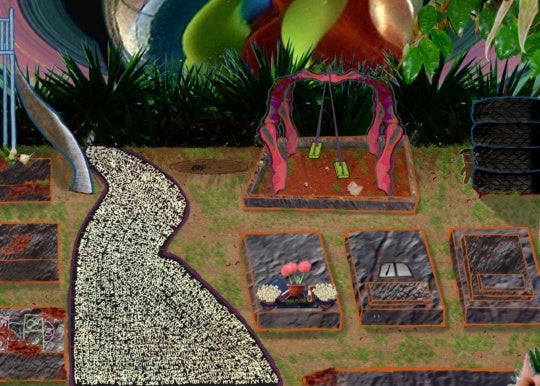
Trapped in an Irish prison in 1937 and suffering from an escalating psychotic break, the troubled avant-garde writer and playwright Antonin Artaud wrote to André Breton that he was continuing his quest to “find that unadulterated intensity of magic and totemism that has been cast out of this confused world,” and proceeded to submit to the Surrealist leader a series of spells written on scraps of burnt paper.[1] Smudged with bodily fluids and unknown liquids, covered with symbols and hanged figures in richly colored ink, and written in a violently performative manner, Artaud’s spells enact a cure for the loss of meaningful communication in an increasingly instrumentalized, rational society. Cruel and threatening, Artaud’s works look to magic to recover a fuller, and thus, more embodied presence in language by drawing attention to the material and physical actions involved in embracing the otherworldly and the ritualistic. Walking through Atlanta Contemporary’s current presentation of “Anna Betbeze: Venus,” a small, but rich exhibition of the artist’s recent work, I felt a trace of Artaud’s quest for uncovering and recuperating a magic—a nature—that has been lost permeating the galleries, specifically in Betbeze’s dyed, burned, ripped wool textile-paintings and the small cauldron-like objects placed between them, accompanying the works like props.

Installed in a side gallery, this exhibition of Betbeze’s works gathers together iconic examples of her practice (such as the large dyed and torn flokati rugs) with works that point to more expanded next steps in her development, such as a rack of flokati garments, small gestural paintings, and a series of coated-black sculptural objects. Stretched in a shallow swag and looming powerful on the wall, Venus (from which the exhibition takes its name) displays the harsh weathering and burning processes so identifiable in Betbeze’s rug works, and reminds us of her interest in the tactile qualities of the shaggy white woolen rectangles and the ways in which she intensifies those qualities through various treatments, physical processes, and performative rituals. Stating that “the soft white wool seemed [the] perfect ground to spill, stain, and defile,” Betbeze buries, burns, cuts, rips, drowns, these works to conflate the optical and haptical conditions associated with painting, but also asks us to make uncomfortable connections between the materiality of the work and the corporeal body—to see the outcome of these violent, aggressive actions as reified debasement.[2] Betbeze’s penchant for immersing the rugs in intensely saturated dyes is evident in Venus—the bottom-left corner having been dipped in a deep electric green-blue, a reminder perhaps of the Goddess of Love’s emergence from the sea, or the limits/borders between opposing genders: a feminine world of nature and lushness vs. a patriarchal world of destruction and violence.

These characteristics explode open in Betbeze’s largest, most commanding work in the exhibition: Opus, In the Flamboyant Grass (2017). Made of multiple rugs in varying dimensions layered upon one another in an undulation reaching from wall to bench to floor, Opus moves dynamically into the space of viewer, treading the line between painting, sculpture, textile, banner, and landscape. The rich colors painted, smeared, dipped, and sprayed onto the woolen fragments seem to be engaged in a messy battle between cool and warmer tones—smears of lipstick red, magenta, and neon orange infiltrate (attack?) the patches of ultramarine and leafy indigos, leaving admixtures that pool and seep into mossy brown wells across the surface. Large and small punctures in the surface of the work, dotted like gunshot wounds, abscesses, burns, or orifices, make a claim for a kind of ruinous beauty, where the significance of the surface, the durability of the surface to hold the weight of the colors and actions thrust upon it, and the places where surface breaks, shapes our attraction or repulsion to the work. In this way, it is almost as if Betbeze locates her actions and intentions ambiguously in relationship to her work. Has Betbeze’s actions caused the breakages, or are we looking at the consequences of a violence, and event, a rupture located outside the work instead? Oscillating between a document of a kind of performance and a nexus of symbolic materials, Betbeze makes ambiguous what these rich surfaces “are”: rug or surface? Image or flesh? Art or castoff? Intention or magic? Intensely rendered, attention is drawn to the artist-magician and the processes that figure the action-magic, leaving the artwork to act as visual evidence of the physical interactions between two bodies and the desire to bridge the gap between them … the very definition of a spell.

While each work in the exhibition is rich in its own right, the small collection of black sculptural objects set in two different configurations render visible the artist’s overt interest in pre-modern ritual and the darker arts. Titled Seasons (2017) and Secrets (2017), the fabricated objects’ deep black surfaces and simple shapes remind one of cast-iron utensils found in pre-modern homes—butter churns, skillets, bowls, and tools—and form a strong contrast to the loaded rugs, suits, and gestural drawings that surround them. The titles point once again to natural cycles and mysterious forces, their charred surfaces signaling an extreme, aggressive violence that expands beyond the term’s association with cooking to natural and manmade environmental disasters and cruel and unusual punishments or torture. Again, Betbeze forces us to question how much weight to give to understanding these works as bodies, and what emotional color to give to that interpretation. Has Betbeze abused them and reincarnated them, or does the charring of the surfaces speak to a history of burning bodies (witches, political dissidents, or religious heretics) that Betbeze is trying to insert her work into?
Betbeze’s work has continually flirted with the line between the two dimensions of painting and the three dimensions of sculpture, and it seems here that she accounts for that interpretation in a modestly literal way. Setting the objects low to the ground, barely pedestaled, these totems speak of an earlier time, give nod to their crucial place in the Southern American imaginary of domestic traditions and communal experiences, and function as icons for the spaces of everyday labor that resonate back to the flokati rugs and their pervasive appearance in domestic interiors as evidence of global travel or trendy design choices.
However, the work is not all violence and destruction—some sense of whimsy, absurdity, delight, and play can be found here too. Thus, the seriousness with which Betbeze engages with her materials and processes, and her gorgeous presentations of color, textures, and painterly actions, always remain in dialogue with a luscious postmodern constellation of interests and references, which circulate the works like fresh air. Understood in this way, Betbeze’s love of pre-modern ruins and Impressionist painting remain just as vital to understanding her work as her interests in English gardens, psychedelia, punk hair dye, Persian carpets, alchemy and astrology, animal sacrifice, and Jim Henson’s Muppets. Perhaps my strong initial interpretation of the exhibition as a theater of cruelty and violence was in reality just resistance to the overwhelming cacophony of visual, psychic, and historical fragments that structure the works themselves—that I mistook beautiful chaos for violent destruction?
1. For an excellent analysis of Antonin Artaud’s engagement with magic and spells, see Ros Murray’s Antonin Artaud: The Scum of the Soul, Basingstoke: Palgrave Macmillan, 2014.
2. Betbeze quote plucked from Sherman Sam’s review “Anna Betbeze: Luxembourg & Dayan (London),” in Artforum, May 2015, p. 189.
“Anna Betbeze: Venus” is on view at Atlanta Contemporary through December 17.
Jordan Amirkhani is an assistant professor of art history at the University of Tennessee Chattanooga. In addition to her academic work, she serves as a regular contributor and art critic to many national arts publications, namely, the San Francisco-based contemporary art forum Daily Serving.




